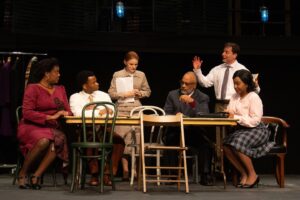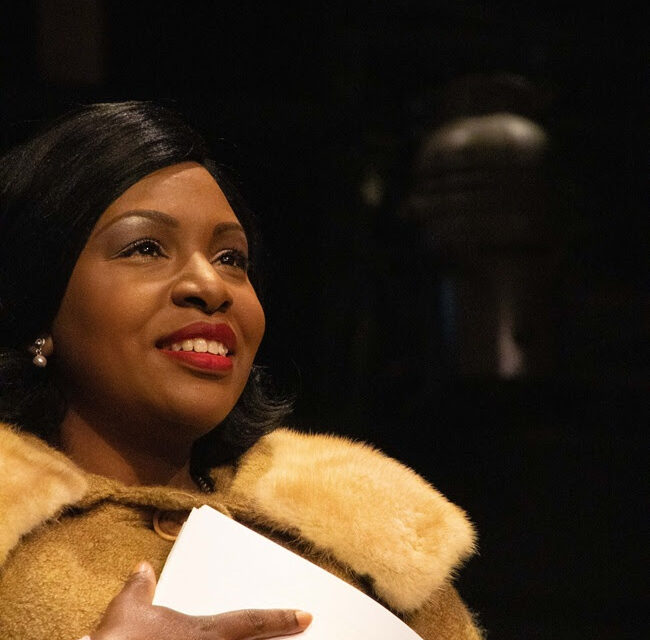Photo Credit: Doug Wood
Aya Wallace as Mayer in RLT’s “Trouble in Mind”
We wear the mask that grins and lies,
It hides our cheeks and shades our eyes,—
This debt we pay to human guile;
With torn and bleeding hearts we smile,
And mouth with myriad subtleties.
-Paul Laurence Dunbar
RALEIGH, NC – How long is “now”?
To a degree, it depends on whom you ask. On the short end, physicists say the notion of “now” is infinitesimally small. Neuroscience says the brain takes two to three seconds to make the “psychological present.” On the distant end, futurist Stewart Brand proposed in the 1990s what he terms “The Long Now” – a time span of twenty millennia, roughly doubling the 10,000-year period between the first emergence of human technology and the present day. Among these meridians other answers can appear to be equally and perhaps even more true, since different cultures experience and process time in different ways.

“Trouble in Mind” Cast. Photo Credit: Doug Wood
So the imperious, ironically named stage director Al Manners is not wrong when he says, “This is now, we’re living this,” during a charged moment in Trouble in Mind, Alice Childress‘ captivating play now running at Raleigh Little Theatre.
The character in this backstage drama is describing a fictive play-within-the-play, called Chaos in Belleville, in which he thinks he’s going to make his directorial debut on Broadway. Manners is more than just convinced that Chaos is of the moment, addressing American culture in the present tense; he’s staking his career on it.
And that’s going to be a problem. Because the year is 1955, Chaos in Belleville is a racial potboiler at best, and Wiletta Mayer, a Black stage veteran with an operatic voice who’s been tapped to play the lead, finds she can no longer play insulting, reductive roles.
Since we haven’t spelled it out yet, Manners is White; so is the playwright who wrote Chaos; and so are the backers putting on this doomed pageant, a state of affairs that’s hardly new in New York theatre at mid-century. “It’s the man’s play, the man’s money, and the man’s theatre,” Mayer says to newbie actor John Nevins, “so what you gonna do?”
Here’s what she, and the rest of the Black actors, are up against. In Chaos, a family of Black and thoroughly disempowered Southern sharecroppers – “simple, backward people,” Manners calls them – still work the former plantation. Ruby, the deeply spiritual, all-wise matriarch, is the family’s anchor and a devoted maid at the plantation house; father Sam and their portentously-named son, Job, work the fields.
Changes are coming, though. Job’s been drafted, and outside agitators have come in, encouraging Black people to exercise the right to vote. When Job does, a lynch mob comes after him.
But instead of helping Job catch a convenient passing freight train to escape the mob, his family, amid the sanctimonious histrionics of his mother (“Lord, touch this boy’s heart…Take the fear and hatred out of his soul!”), effectively delivers the son into their hands instead. This takes place despite the noble but ineffectual efforts of the wealthy White landowner, who convinces the mob – too late, of course – that they’re wrong.
Manners concludes that Job’s a sacrificial lamb, offered to make “one beautiful, clear point…violence is wrong.”
Mayer, who plays mother Ruby, disagrees: “The writer wants the damn White man to be the hero – and I’m the villain!” She then refuses to go on: “I’m sick of people signifyin’ we got no sense…I want this script changed, or else!”
But Manners clearly brings this revolt on himself. In mid-century, Childress notes, the “method” of Konstantin Stanislavsky may have been the latest thing, but it was still a new experience for Black actors long accustomed to playing stereotypical roles. Manners doesn’t know the forces he’s unleashing when he dresses down a bewildered Mayer in a rehearsal: “It won’t do…You’re not carrying a tray or answering doorbells; this is substance, meat. I demand that you know what you’re doing and why, at all times. I will accept nothing less.”
Manners claims he’s only after the truth in his stagings. Then he comes up with a very self-serving definition of the term: “Truth is simply whatever you can bring yourself to believe. That is all.”
Dangerous words, all in all, to say to an actor who, up to then, has spent her entire career on artistic autopilot. When Mayer’s given agency to start filling in the blanks for her character’s motivation herself, Manners may not be pleased with the results.
Indeed, he later tries to reverse course, telling Mayer, far too late, “Make me a solemn promise. Don’t start thinking.”
But when Mayer has to know, for herself, why her character would send her son into a lynch mob, she reaches this conclusion: “Talkin’ ’bout the truth is anything I can believe. Well, I don’t believe this…I’m his mother and I’m sending him to his death. This is a lie.”
Grammarians will note the present tense in the previous sentence. It’s identical to the tense in Manners’ opening assertion, “This is now.” Both describe the same play, Chaos, in the same time, but they can’t be reconciled. Bookmark that thought, for a moment.
I’ve gone into considerable detail on the play-within-a-play to leave the biggest questions in Childress’s main play unanswered. What happens when a troupe of Black actors in the middle of the last century are confronted with yet another reductive script that reinforces the racial status quo, and an egotistical White director mistakenly convinced he’s pursuing something groundbreaking in the staging of it? What will happen when its lead calls out the gross racism in the text and refuses to go further?
But Childress isn’t finished. Her transgressive play poses questions bigger than these, involving honesty, authenticity and survival.
In trying to clue in an inexperienced young actor on how to play the game of being a Black actor working with White directors and playwrights, the company’s veterans spell out the unspoken rules of survival. With dismay, we soon learn their use isn’t limited to show business, or even interactions across racial lines.
Don’t let them know you’re educated (“They want us to be naturals, just born with the gift”). Don’t be too cocky. Flatter, and laugh at everything they say (“Makes ’em feel superior”). Above all, when asked for honest opinions, lie.
We watch when the characters put in practice all of these survival strategies and more.
Then we reflect on the times in our own lives when we’ve used these stratagems ourselves, or had them used on us.
If Harlem Renaissance poet Paul Laurence Dunbar offered a masterclass in weaponizing his famous poem, “We Wear the Mask,” it might look a lot like this.
But the biggest questions in Childress’ compelling drama just might be these: What if the mask cracks? What happens when it can no longer fit? What then?
Regional veteran Derrick Ivey‘s superb set design (complete with twinkling, Tiffany-style lamps above the audience) transforms the Gaddy-Goodwin Theater into something never seen before there: an old-school proscenium stage between runs, where rehearsals are in progress. A new upstairs balcony provided a refreshing perspective, but just-constructed steps and seats unsecured to the floor during the first weekend gave us some concern.
Under Kenneth Hinton‘s direction, Aya Wallace, an actor long undersung on the regional stage, steps to the front here as Mayer, the actor who can no longer wear the mask, and a very sharp David Keats convinces as autocratic director Al Manners.
Other roles have flash, but lack some of the polish and consistency in these twin leads. Terry Crymes brings the snark to start with as the age-obsessed, out-for-herself actor Millie Stark, but her edge fades instead of sharpens further into the script. Kevin Burke admirably fleshes out the rough-edged, cluelessly racist actor Bill O’Wray, but director Hinton and he never get at the absurdity of his second act monologue as the wealthy landowner (and would-be statesman), Reynard. That top-heavy string of clichés, historically used to justify racial injustice, reaped plentiful laughter when PlayMakers Rep staged the work.
Beginning actor Kelly Lumpkin acquits himself surprisingly well in his first production (ever) as elder actor and irritating yes-man Sheldon Forrester. Other supporting roles were less developed, and less persuasive.
Back to my initial question: How long is “now”?
I ask it for one reason. Alice Childress had been an actor for well over a decade, on and off Broadway, before she wrote Trouble in Mind. As we’ve mentioned, she wrote the drama about the intolerable conditions she’d observed on the professional stage during her own career. That time period began in the late 1930s.
Trouble in Mind was first produced off-Broadway in 1955.
Its Broadway premiere took place 66 years later, in October 2021. It was one of the first shows to reopen Broadway toward the end of the pandemic lockdown.
Six years before that, PlayMakers staged its regional premiere in 2015.
At the time Childress wrote Trouble in Mind, she set it two years into the future: in the fall of 1957.
It was a measure of just how out of touch Manners was – with his culture, his times and the lives of his Black actors – when he vehemently and erroneously said, “This is now, we’re living this,” of his retrograde play.
Let’s fully stipulate that a similar assessment of Trouble in Mind raises the possibility, in theory at least, of the same error.
And yet. In 2020, eight decades after Childress began documenting racism on and behind the professional stage, a theatrical protest movement titled We See You, White American Theatre demanded systemic changes across the field to combat ongoing inequities. Locally and at the national level, artistic directors, administrators, and other creatives convened during the early years of the pandemic to study, adopt, and implement anti-racism protocols in management and professional practices as a result.
Still, broad inequities exist, in regional as well as national theatre.
We thus conclude, when we assess Trouble in Mind as a work that remains firmly rooted in the present tense, that the current activists echo the words Childress herself said of her colleagues, their working conditions, their culture and time:
It’s still now. We’re still living this.
So. After eighty-plus years and counting, Trouble in Mind still asks: How long is “now?”
Even more pressing: How long does it have to remain?
Trouble in Mind continues at Raleigh Little Theatre through Sunday, March 31.











